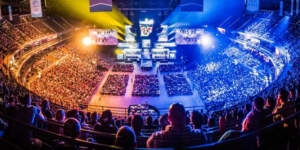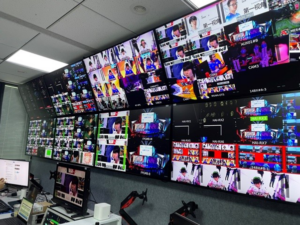Unravelling the Technicalities of AV Systems in Esports Arenas
Esports, a burgeoning industry on the cusp of a new era, has seen a meteoric rise over the last decade. Once considered niche, esports have blasted into mainstream culture, a testament to the seismic shifts in the terrain of competitive sports.
By Matthew Hale

Esports, a burgeoning industry on the cusp of a new era, has seen a meteoric rise over the last decade. Once considered niche, esports have blasted into mainstream culture, a testament to the seismic shifts in the terrain of competitive sports. Esports arenas, the pulsating heart of the esports community, serve as hallowed battlegrounds where players and spectators unite in their shared passion. A crucial element underpinning the allure and immersive experiences offered by these arenas lies in the technical complexity and intricate design of the audio-visual (AV) systems. This article seeks to explore these systems and their intricacies in detail, focusing on the specifics of AV signal flow within the esports arena ecosystem.
Mirroring traditional sports stadiums, modern esports arenas have burgeoned in size to accommodate the swelling ranks of esports enthusiasts. These venues are multi-faceted spaces, each segment serving a distinct function. The arenas encapsulate the main stage for competitors, audience areas, commentary booths, and control rooms, each necessitating unique AV setups tailored to their respective requirements.

The Signal Flow: How the Magic Unfolds
Esports AV systems core purpose is to deliver a seamless spectacle that synchronises and integrates various elements: players real-time gaming actions, live audience reactions, online viewers interactions, and commentators analysis. Simultaneously, it must process and display a multitude of information such as scores, player statistics, and live gameplay.
At the heart of this network lies the signal flow, the cornerstone on which the entire AV system operates. Understanding the signal flow is key to appreciating the technical nuances of esports AV systems.
Source Devices: The signal flow begins at the source, typically the gaming PCs used by players. These devices must be high-powered to run games smoothly at ultra-high settings. This is crucial as any lag or delay can compromise competitive fairness and hinder the player’s gaming experience.
Transmission Infrastructure: The signal then travels through an intricate web of cables and connections. A combination of HDMI, DisplayPort, and Thunderbolt technologies are employed to deliver the high-bandwidth data streams necessary for top-tier gaming and broadcasting. Fibre optic cables may also be utilised for long-distance signal transmission without loss or interference. Everything must be zero latency.
Processing and Switching: The signals are then passed to a central processing unit that serves as the control hub for the entire arena. This hub must have the capacity to handle multiple high-definition video streams in real-time. Video switchers are used to manage these multiple inputs and determine which signal is displayed on the main screens, auxiliary displays, or broadcasted online. Avoid scaling and signal conversion.
Projection and Display: After processing, the signals are sent to the various display devices within the arena. The main gameplay is projected onto large LED walls, providing viewers with a high-definition, immersive visual experience. Smaller, auxiliary displays scattered around the arena show supplementary data like player stats, live chats, and social media interactions.
Audio Routing: Parallel to video, the audio signals, which include game sounds, player communications, and commentators’ voices, are routed through a separate pathway. A digital audio workstation (DAW) is used to manage and mix these sounds. The DAW controls the volume levels, audio effects, and the routing of sounds to the various speakers and headphones throughout the arena.
Broadcasting: Finally, a portion of the video and audio signals is routed to a broadcast system for live streaming. The system utilises encoding technology to convert the AV signals into a format suitable for online transmission. Different broadcasting platforms may require specific encoding standards, which the broadcasting system must accommodate.

To delve deeper into the signal flow, let’s explore the distinct sections of an esports arena and their respective AV requirements.
- The Stage: The focal point of the arena, this is where players wage their digital battles. Each player’s setup includes a high-performance gaming PC and peripherals, and a display screen. The PCs output video signals (game visuals) and audio signals (game sounds, player communications) to the main processing hub. Here, the signals are managed and routed to the stage displays, the PA system for in-arena sound, and the broadcasting system for live streaming. It is important to ensure that the player’s monitor and controls are locally connected, and only auxiliary video outputs are to be used for signal distribution.
- The Audience Area: Designed for the live spectators, this section requires a variety of display screens and speakers. The video signals from the processing hub are routed to the screens, while the audio signals feed into the arena’s PA system. Signal amplifiers may be used to ensure clear, high-definition visuals and powerful, distortion-free audio throughout the arena.
- Commentary Booths: Housing the commentators, these soundproof booths require their AV setup. Microphones in the booths capture the commentators’ voices, which are then mixed with game sounds at the central processing hub and routed to the PA system, the broadcast system, and the player’s headphones.
- Control Room: The technical epicentre of the arena, the control room, houses the main processing hub, the DAW, and the broadcasting system. Technicians in the control room monitor and control the signal flow, managing video feeds, audio levels, and live streaming. It may also be necessary to record all of these sources separately so that gameplay can be reviewed to discourage hacking or cheating.

Sophisticated Audio Systems
Audio systems in esports arenas demand a unique combination of capabilities. They must deliver clear, high-fidelity game sounds and commentary to both the live audience and the online viewers. At the same time, they must provide a separate, secure audio channel for player communications.
Microphones capture the commentators’ voices and player communications, while speakers and headphones output the various audio feeds. Digital mixers and audio processors manage these signals, controlling volume levels, applying audio effects, and ensuring clear, balanced sound. For player communications, noise-cancelling technology is often used to block out ambient noise, and encryption may be used to secure the communication channel.
Beyond the raw AV signals, other elements contribute to the immersive experience of an esports event. Lighting systems, for example, create an atmospheric ambiance, enhancing the spectacle with dramatic, programmable light shows.
Broadcasting, on the other hand, takes the event to a global audience. Multiple high-definition cameras capture different viewpoints, from wide arena shots to close-ups of players and spectators. These video feeds, along with the audio feeds, are routed to the broadcasting system. Here, the signals are encoded into a streaming-friendly format, and then uploaded to the internet for live streaming. Thie broadcasting system alone can be equally as complex if not more so than the arena itself.

Needless to say, a lot of people are required to satisfy all of these requirements. Esports events held in huge arenas can have hundreds of technical staff, all of them essential to the smooth operation of the critical AV systems.
In the ever-evolving world of esports, the complexity of AV systems is growing in parallel with the scale and spectacle of the events themselves. As the stakes rise, the success of an esports event increasingly hinges on the performance of the AV system. Despite their technical complexity, these systems are the lifeline of esports arenas, conjuring immersive, thrilling experiences that push the boundaries of entertainment. Looking to the future, we can anticipate a continuous crescendo of technological advancements, with even more sophisticated AV systems set to redefine the esports experience. The journey of esports from the fringes to the forefront of the sports and entertainment industry is a testament to the fusion of technology, strategy, and human skill, a spectacle that promises to captivate audiences for generations to come.
Latest Blog
No results found.....